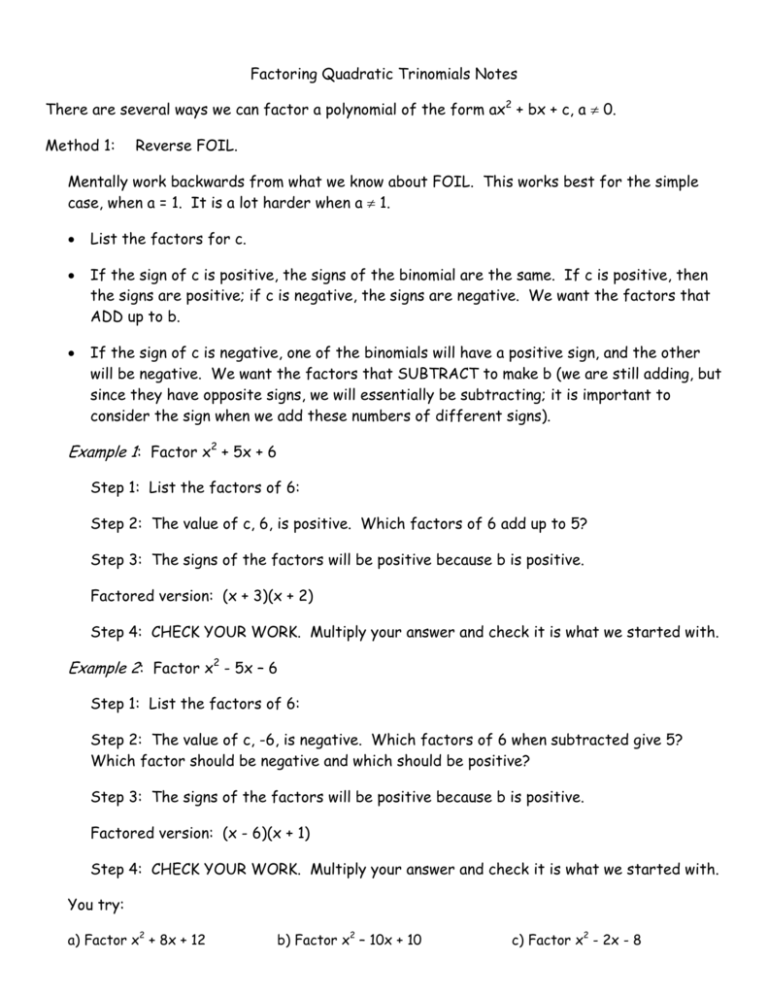Factoring Quadratic Trinomials Notes There are several ways we
advertisement

Factoring Quadratic Trinomials Notes There are several ways we can factor a polynomial of the form ax2 + bx + c, a ≠ 0. Method 1: Reverse FOIL. Mentally work backwards from what we know about FOIL. This works best for the simple case, when a = 1. It is a lot harder when a ≠ 1. • List the factors for c. • If the sign of c is positive, the signs of the binomial are the same. If c is positive, then the signs are positive; if c is negative, the signs are negative. We want the factors that ADD up to b. • If the sign of c is negative, one of the binomials will have a positive sign, and the other will be negative. We want the factors that SUBTRACT to make b (we are still adding, but since they have opposite signs, we will essentially be subtracting; it is important to consider the sign when we add these numbers of different signs). Example 1: Factor x2 + 5x + 6 Step 1: List the factors of 6: Step 2: The value of c, 6, is positive. Which factors of 6 add up to 5? Step 3: The signs of the factors will be positive because b is positive. Factored version: (x + 3)(x + 2) Step 4: CHECK YOUR WORK. Multiply your answer and check it is what we started with. Example 2: Factor x2 - 5x – 6 Step 1: List the factors of 6: Step 2: The value of c, -6, is negative. Which factors of 6 when subtracted give 5? Which factor should be negative and which should be positive? Step 3: The signs of the factors will be positive because b is positive. Factored version: (x - 6)(x + 1) Step 4: CHECK YOUR WORK. Multiply your answer and check it is what we started with. You try: a) Factor x2 + 8x + 12 b) Factor x2 – 10x + 10 c) Factor x2 - 2x - 8 Method 2: Box Method This method works well for any value of a. • Draw a 2x2 box. Put ax2 in the upper left box and c in the lower right box. • Multiply a*c. List the factors. Based on the signs of the trinomial, we can determine whether we want factors that add up or subtract to c (see method 1). • Place the factors as coefficients to the x-variable in the remaining boxes. • Extract common factors vertically and horizontally. These are your binomials! Example: 2x2 – 5x – 3 You try: 2x2 – 7x + 12 Method 3: Diamond Method This method works for any value of a. Steps: • • • • • In the top, put the product of a and c. In the bottom, put the value of b. The left and the right locations are the numbers that when multiplied, give u us ac, and when added, give us b, that is ef = ac and e + f = b. Put a fraction bar over the left and right values, and put a on top. Reduce. The top part of the fraction bar is the x x-coefficient of the e binomial factor, and the bottom part is the constant part. Example: 2x2 – 5x – 3 1) 2) 3) Factored version: (x - 3)(2x + 1)…CHECK BY MULTIPLYING! You try: 6x2 – x – 2 4) Method 4: Slide and Divide This method works well for any value of a. • “Slide” the leading coefficient,a, to the end, and multiply it by c. Pull out common factors, if any. • Now we have the “simple” case, when a = 1. Factor using method 1. • “Put back” the number you slid by dividing the number in each binomial by a. • Simplify the fractions. If there is a denominator left in one of the binomials, make it the coefficient of the x-term for that binomial. Example: Factor 3x2 + x – 10 Step 1: Slide a (3) to the end, multiplying by c (-10): x2 + x – 30 Step 2: Factor using method 1: (x + 6)(x – 5) Step 3: Divide numbers by a: (x + 6/3)(x – 5/3) Step 4: Simplify fractions: (x + 2)(x – 5/3) Step 5: Hey, there’s a fraction left! Move the denominator in front of the coefficient: (x + 2)(3x – 5) Step 6: CHECK YOUR WORK. Multiply your resulting factors to check it is correct. You try: Factor 2x2 -7x + 5 Practice Factor the following trinomials. You may use any method you wish, but try a few of them to help you find your favorite! 1) x2 + 6x + 5 2) x2 – 4x – 12 3) x2 – x – 12 4) p2 + 9p + 14 5) 2w2 + 7w + 3 6) x2 + 2x - 24 7) 4x2 - 4 8) 5a2 – 8a – 4 9) 3n2 + 13n + 4 10) –x2 –4x + 5











